#and the ones with ocelli have cute little faces
Explore tagged Tumblr posts
Text
Round 1 - Phylum Nemertea
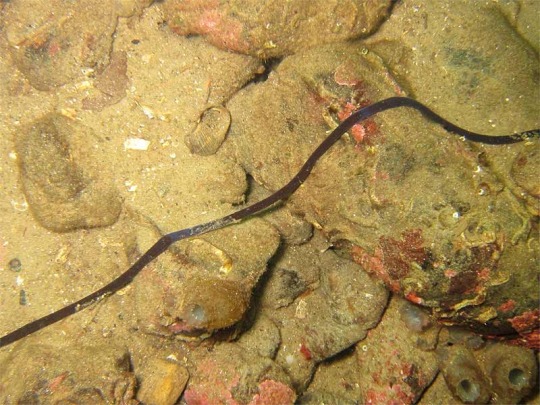
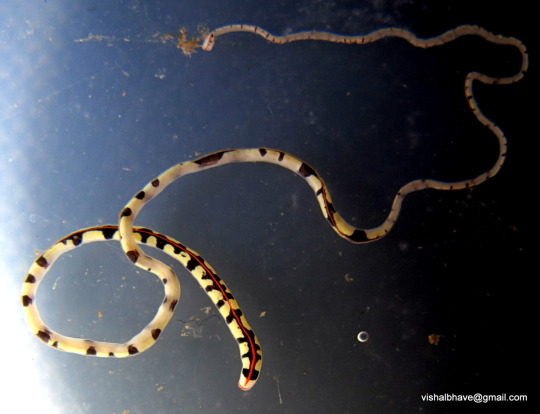
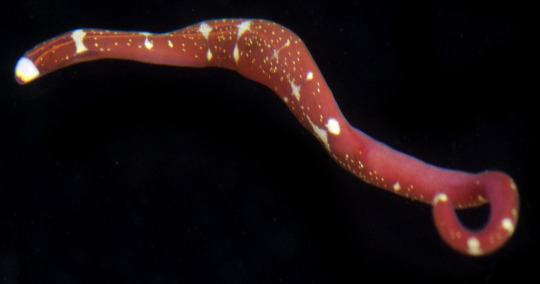
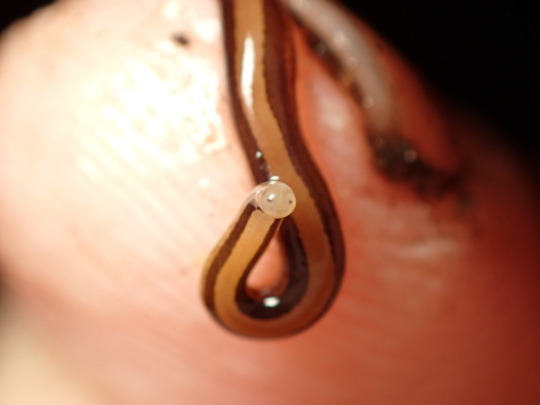
(Sources - 1, 2, 3, 4)
Animals in the Phylum Nemertea, commonly known as “Ribbon Worms” or “Proboscis Worms,” are small and mostly slim with a venomous proboscis that everts just above to mouth to capture prey.
There are about 1,300 known species of nermertean. Most nemerteans are carnivores, feeding on annelids, clams, and crustaceans. Some species are scarvengers. Some species are filter feeders that utilize a sucker at the front and back ends of their bodies to attach to a host. Most nemerteans detect the world through the use of chemoreceptors, but some species have simple eyes that allow them to distinguish light from dark. They move slowly, using cilia to walk on a trail of slime. Some larger species can “slither.” Many are brightly colored and patterned. Most nemerteans are marine, living in either the open ocean or on the sea floor, but some species are freshwater, and some are even terrestrial.

Propaganda under the cut:
Previously, nemerteans were split into two groups by whether they had a “little dagger” on their proboscis or not. (This classification no longer applies as one of the “unarmed” orders was closer related to the “armed” group than the rest of the “unarmed” group. It’s still fun to imagine worms with little daggers tho.)
The Bootlace Worm (Lineus longissimus) (seen in the first image) is one of the longest known animals, with specimens up to 55 m (180 ft) long being reported. This is longer than the Lion’s Mane Jellyfish, the sauropod dinosaurs Argentinosaurus and Patagotitan, and the record-holding longest Blue Whale. Like other nemerteans, the Bootlace Worm can also stretch up to 10 times its resting length. They’re not considered the largest animals though, because they’re only 5 to 10 mm (0.20 to 0.39 in) wide!
As a defense against predators, the Bootlace Worm produces a toxic mucus which contains a strong neurotoxin and smells faintly of “iron or sewage.” The mucus has been shown to kill arthropods, and is being studied for its use as a natural pesticide.
Some larger species can regenerate, breaking into pieces when disturbed, after which the fragments can grow into full individuals!
Some nemerteans have a branched proboscis that comes out as a “mass of sticky spaghetti” that can then be used to pull prey into its mouth. If you love horror movies, this is the animal for you! I’m not easily grossed out, but I genuinely can’t stomach this video, so viewer discretion is advised! (Thankfully, this one didn’t have a “little dagger.”
#animal polls#round 1#how come before I typed anything in the gif search bar Brennan Lee Mulligan was the first gif Tumblr suggested I use#anywaaaay#i am genuinely sorry but these are some of the only animals that give me the Ick#the colorful ones are nice and I am impressed by the bootlace worms length#and the ones with ocelli have cute little faces#but that spaghetti proboscis is Just#A Lot#and I wasn’t about to use THAT as a gif so you get living intestines instead#nemertea
40 notes
·
View notes
Text
HEY WANNA SEE A COUPLE FUCKED UP MUTANT BEES?
so i've mentioned in the past that while i don't go out of my way to catch bees, they often end up in the pest monitoring trap samples that i process for work. since i hate seeing cute animals go to waste i've made a project out of pinning and identifying them whenever possible. one of the more common bees that i see around this time of years are the tiny & shiny genus Ceratina:


(not my photos, but the rest in this post are mine)
(fun fact they're actually most closely related to the giant carpenter bees you're probably more familiar with)
okay so for reference here's a couple examples of standard male Ceratina faces:


kinda silly looking! but now check out this freak i found this week:


note that not only are the eyes nearly wrapping around the face but the ocelli are totally missing and the antennal insertions have merged into a weird giant pit in the middle of his face. sadly he's a little beat up and one of the antennae was broken off along with some leg parts.
but okay if you think that's weird, check out this NEXT guy:





what the fuck! that smaller antenna isn't broken off like the previous guy it's just... like that. i have absolutely no explanation for either of these oddities.
honestly Ceratina are so common that i'd almost gotten to the point of not bothering to keep them when they show up in my traps but i'm really glad i took a closer look and spotted these freaks. have not attempted to ID either to species yet.
638 notes
·
View notes
Text
when i took entomology class, we had a bonus question at the end of an exam that was just like, “What is your favorite insect and why?” and i earnestly wrote about honeybees, which i realized later is the most basic bitch answer you could possibly give. so here is my new and improved answer.
my favorite insects are cicadas, for the following reasons
cute wide head
weird little grill on their face and i like that
good ocelli
very large but won’t bite you
not very flighty (i.e. if you find one you can probably just pick it up and it won’t abscond) (sometimes just because it’s near death, but still)
clumsy at flying, which is endearing
spend years in the earth digging around with cute fossorial forelegs and drinking delicious tree sap and then come to the surface and yell for the last three months of life
found a cicada shell? hook it onto your hat and it will stay. now you have an accessory
the mechanism they use to make sound is like a popping jar lid but multifaceted like a bendy straw and they pop it like a hundred times a second
sound is amplified by their hollow abdomen, and they wiggle it to make the sound different, and i think that’s funny
some species have a very fashionable pattern on their back
shaped like a friend
#not that honeybees aren't good. they're fine. i mean native bees are better. but forget about hymenoptera for now#it's time to focus on cicadas.#cicada
131 notes
·
View notes
Note
How many legs? Also how many eyes? Just 2? Are they compact like flies?
Legs!
Centipedes vary in leg number, but the constant is that they'll always have an odd number of pairs, so they never actually have a hundred legs! And they only have one leg per segment as well, where as millipedes have two, as a quick way to tell them apart if you're ever unsure.
The actual number can be between 30 and 354, depending on species. 30 legs, or 15 pairs, you can see on house centipede species. Genus scolopendra (my namesake and what tend to be referred to as the 'giant centipedes') tend to have 42~46 legs or 21~23 pairs. Soil centipedes, or geophilomorpha are a large order, but they seem to boast the pedes with the most legs- they practically look like worms!! It's and easy bet to say these guys are the ones boasting the grand title of 354, or at least one species is, finding info on them can be tough! I'll probably read up on scientific articles later and add to this if I find the specific culprit!
And! It's worth nothing you want to include the terminal legs - that being the final, usually long or unusual looking leg pair facing straight back on the end of their bodies - and the forcipules - or fangs - in your leg count, should you try to count yourself! Both are modified legs, the forcipules in particular being specialized for venom delivery!
Eyes!
Like legs, centipedes eyes vary as well from species to species. Plenty of species don't have eyes at all, usually the itty bitty guys which makes up most centipedes. Those that do have 'eyes' (ocelli) have a varying number of them, and they do infact cluster together to form compound eyes in some cases! They're all still pretty much blind though, and can only really discern light and dark. They use other means to navigate their world!
If you look at close up pictures of house centipedes, they have your classic compound eyes. Scolopendra species, such as dehaani or gigantea, have a small amount of individual ocelli, but no true compound eyes, usually 3-5 on either side from what I've observed. They're not arranged around the head like you may see in things like spiders or scorpions and stay in one area, clustered right behind the antenna.
Photos under cut to spare scolopendraphobes

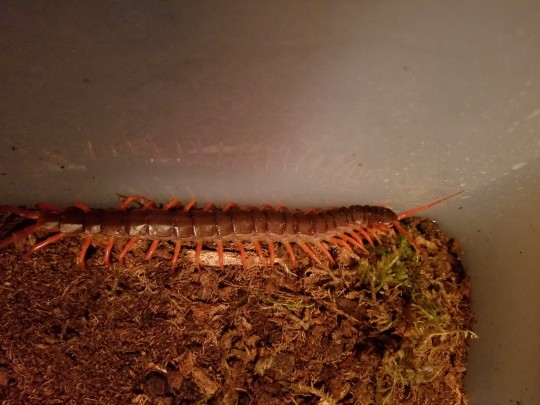
A house centipede, soil centipede, and scolopendra centipede (actually my late pede Kulo, RIP!). The difference in leg number is pretty clear, along with body type!

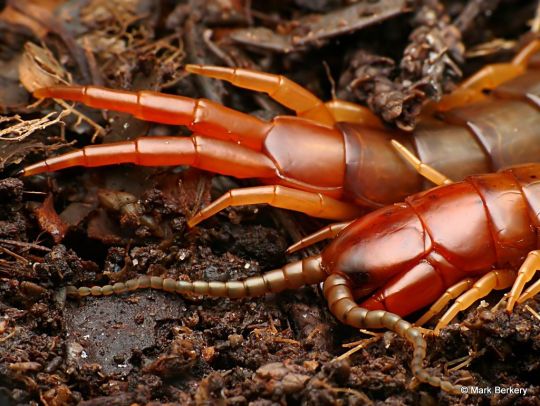

Variations of terminal legs. They have interesting varying functions of their own!

Forcipules open, you can kinda see how they are modified legs. (Pic is my first ever and also late centipede girl Tuli. She was drinking water off her enclosure wall after I gave it a good misting which is why she is a little wet lol. I do try to avoid getting them wet though. She was thorsty after hurricane evac.)

Eyelsss soil centipedes and compound eyes on a house centipede



A good look at the distinct multiple ocelli on scolopendra. (These kinds of pics are my favorite bc they're so cute. The first one looks like it has a little cat mouth :3 help. Also the little spiral way they'll hold they're antennae sometimes I 🥺🥺🥺🥺 ...lil mustache)
12 notes
·
View notes